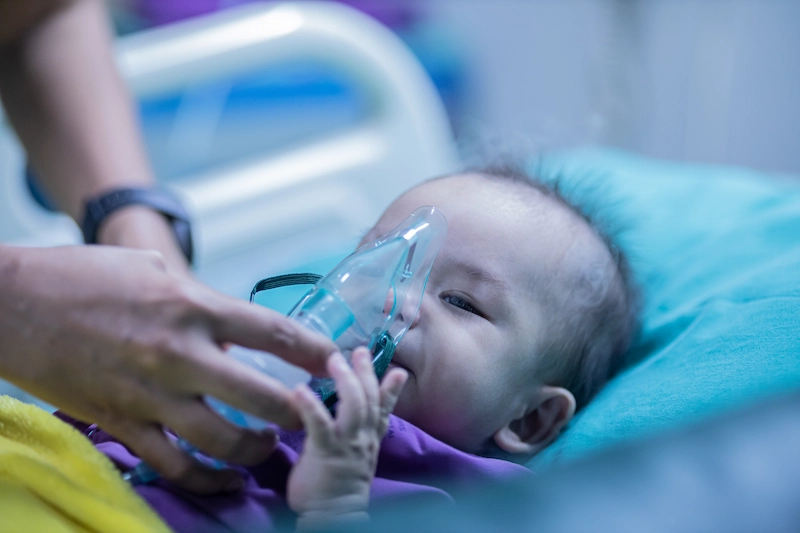General Health
Potentially Dangerous, Here Are the Symptoms of Pulmonary Atresia in Newborns
Share to

Table of Contents
Pulmonary atresia is a congenital heart disorder that affects the blood flow from the heart to the lungs. This condition occurs when the pulmonary valve is either not underdeveloped or completely closed, preventing blood from flowing to the lungs the way it should to receive oxygen. So, what causes pulmonary atresia? How can it be managed? Discover more information here.
What Is Pulmonary Atresia?
Pulmonary atresia is a congenital heart disorder where the pulmonary valve does not develop properly or is closed after birth. If the pulmonary valve does not function, blood cannot flow into the pulmonary arteries and reach the lungs to receive oxygen. As a result, the blood circulating throughout the body is oxygen-poor.
The pulmonary valve is one of the four valves in the heart. It is located on the right side of the heart, between the right ventricle and the pulmonary artery (the blood vessel that carries blood to the lungs). Normally, the pulmonary valve opens to allow blood to flow from the right ventricle into the pulmonary arteries.
There are two types of pulmonary atresia. Here are the details for each:
-
Pulmonary atresia with ventricular septal defect (VSD): In this condition, the valve between the heart and lungs is not fully formed, so blood cannot flow from the right ventricle to the lungs. There is also a hole between the two pumping chambers of the heart.
-
Pulmonary atresia with intact ventricular septum: The wall between the left and right sides of the heart is intact. In other words, there is no hole between the two ventricles or chambers of the heart. As a result, the blood does not receive enough oxygen.
Causes of Pulmonary Atresia
Until now, the exact cause of pulmonary atresia has yet to be known. The baby's heart begins to form and beat during the first six weeks of pregnancy. The main blood vessels that carry blood to and from the heart also start to develop during this critical period. Pulmonary atresia can occur during this stage of development.
Certain health conditions or the use of illicit drugs during pregnancy may increase the baby’s risk of developing pulmonary atresia or other congenital heart disorders. Specifically, the following factors may heighten the risk:
-
Alcohol or tobacco consumption.
-
Use of certain medications during pregnancy, such as specific acne medications or blood pressure medications.
Some types of congenital heart disorders are inherited within families. In other words, someone born into a family with a history of congenital heart problems has a higher risk of experiencing the same issue. Typically, doctors will recommend genetic testing during pregnancy to assess the risk of certain congenital heart disorders in future children.
Symptoms of Pulmonary Atresia
Pulmonary atresia symptoms often appear within a few hours or the first few days after birth. These symptoms include:
-
Rapid or shallow breathing.
-
Bluish color of the skin (cyanosis), especially around the lips, fingers, and toes.
-
Cold, pale, or damp skin.
-
Easily fatigued or tired.
-
Difficulty feeding.
Diagnosing Pulmonary Atresia
During pregnancy, the doctor will perform screenings to check fetal health. If the doctor finds anything concerning in the ultrasound results, a fetal echocardiogram may be performed. This procedure uses sound waves to take a closer look at the fetal heart.
However, a diagnosis can only be confirmed after the baby is born. Once the baby is born, the doctor will examine the heart and lungs to check for any issues. Additionally, the doctor may conduct other tests, including:
-
Pulse oximetry: To measure the oxygen levels in the baby's blood.
-
Chest X-ray.
Treatments for Pulmonary Atresia
A baby diagnosed with pulmonary atresia requires immediate emergency medical care. Pulmonary atresia treatment options will be tailored to the severity of the patient’s condition and may involve medications or other procedures. More details are as follows:
-
Medications: Medications can be administered through an infusion to keep the ductus arteriosus open. While this treatment is not a long-term solution for pulmonary atresia, it can give the healthcare team more time to determine the best surgical or procedural intervention for the patient.
-
Other procedures: In some cases, treatment for pulmonary atresia can involve the use of a long, thin tube called a catheter. Some of the catheterization procedures include:
-
Balloon atrial septostomy: A balloon is used to enlarge the natural hole in the wall between the upper chambers of the heart. This helps blood flow more easily from the right side of the heart to the left.
-
Stent placement: A doctor may place a rigid tube called a stent in the ductus arteriosus to prevent it from closing. This ensures blood continues to flow to the lungs.
Patients with pulmonary atresia often require various types of heart surgeries over time. The type of surgery depends on the size of the lower right heart chambers and pulmonary arteries. Some surgical options for pulmonary atresia include:
-
Shunting: This procedure creates a new route for blood flow called a shunt. The shunt directs blood from a major blood vessel leaving the heart (the aorta) to the pulmonary arteries, allowing sufficient blood flow to the lungs.
-
Glenn procedure: This surgery involves connecting one of the large veins returning blood to the heart to the lungs. Meanwhile, the other large vein continues to carry blood to the right side of the heart, where it is pumped through the repaired pulmonary valve. This can help the right ventricle grow.
-
Fontan procedure: If the right ventricle remains too small to perform its function, the doctor can utilize this procedure to create a pathway that allows most of the blood entering the heart to flow directly into the pulmonary arteries.
-
Heart transplantation: In some cases, the heart damage is too severe to be repaired, thereby necessitating heart transplantation.
Complications of Pulmonary Atresia
Without proper treatment, pulmonary atresia can lead to death. Even after surgery, babies need regular follow-up exams throughout their lives to monitor any potential complications. Some of the complications that may arise due to pulmonary atresia include:
-
Bacterial infection of the inner lining of the heart and valves (endocarditis).
-
Irregular heart rhythms (arrhythmia).
-
Weakening heart function.
It is important to note that the symptoms mentioned above do not specifically represent pulmonary atresia. These symptoms can be similar to those of other medical conditions. Therefore, if your little one experiences symptoms such as rapid breathing or a bluish skin color, do not hesitate to consult a Pediatric Cardiologist at the nearest Siloam Hospitals.
The examination and treatment procedures recommended by doctors or other healthcare professionals for this condition may vary depending on the available healthcare facilities at each hospital. Nevertheless, medical professionals will determine the appropriate examination and treatment steps according to each patient's medical condition.
You can use the MySiloam app to book an appointment with the relevant doctor and check your health examination results virtually. Download MySiloam now to enjoy various features that can facilitate your healthcare journey.
Sumber
CDC. About Pulmonary Atresia. Diakses pada 2024 | Cleveland Clinic. Pulmonary Atresia. Diakses pada 2024 | Mayo Clinic. Pulmonary atresia. Diakses pada 2024 | Boston Children’s Hospital. Pulmonary Atresia. Diakses pada 2024 |








